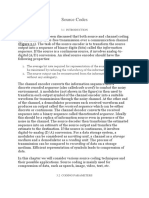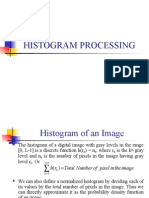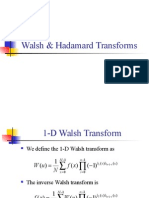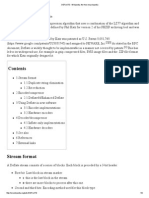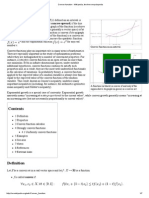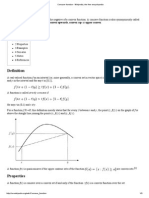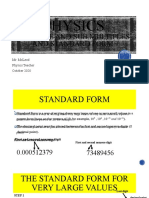Entropy Coding
Uploaded by
Rakesh InaniEntropy Coding
Uploaded by
Rakesh InaniLecture 5:
Introduction to Entropy
Coding
Thinh Nguyen
Oregon State University
Codes
Definitions:
Alphabet: is a collection of symbols.
Letters (symbols): is an element of an alphabet.
Coding: the assignment of binary sequences to
elements of an alphabet.
Code: A set of binary sequences.
Codewords: Individual members of the set of binary
sequences.
Examples of Binary Codes
English alphabets:
26 uppercase and 26 lowercase letters and
punctuation marks.
ASCII code for the letter a is 1000011
ASCII code for the letter A is 1000001
ASCII code for the letter , is 0011010
Note: all the letters (symbols) in this case use
the same number of bits (7). These are called
fixed length codes.
Examples of Binary Codes
English alphabets:
26 uppercase and 26 lowercase letters and punctuation
marks.
ASCII code for the letter a is 1000011
ASCII code for the letter A is 1000001
ASCII code for the letter , is 0011010
Note: all the letters (symbols) in this case use the same
number of bits (7). These are called fixed length codes.
The average number of bits per symbol (letter) is called
the rate of the code.
Code Rate
Average length of the code is important in compression.
Suppose our source alphabet consists of four letters a1, a2, a3,
and a4 with probabilities P(a1) = 0.5 P(a2) = 0.25, and P(a3)
= P(a4) = 0.125.
The average length of the code is given by
4
l = P(ai )n(ai )
i =1
n(ai) is the number of bits in the codeword for letter ai
Uniquely Decodable Codes
Letters
a1
a2
a3
a4
Probabilitity
Code 1
Code 2
Code 3
Code 4
0.5
0.25
0.125
0.125
0
0
1
10
1.125
0
1
00
11
1.25
0
10
110
111
1.75
0
01
011
0111
1.875
Average Length
Code 1: not unique a1 and a2 have the same codeword
Code 2: not uniquely decodable: 100 could mean a2a3 or a2a1a1
Codes 3 and 4: uniquely decodable: What are the rules?
Code 3 is called instantaneous code since the decoder knows the
codeword the moment a code is complete.
How do we know a uniquely decodable
code?
Consider two codewords: 011 and 011101
Prefix: 011
Dangling suffix: 101
Algorithm:
1.
Construct a list of all the codewords.
2.
Examine all pairs of codewords to see if any codeword is a prefix
of another codeword. If there exists such a pair, add the
dangling suffice to the list unless there is one already.
3.
Continue this procedure using the larger list until:
1.
Either a dangling suffix is a codeword -> not uniquely decodable.
2.
There are no more unique dangling suffixes -> uniquely decodable.
Examples of Unique Decodability
Consider {0,01,11}
Dangling suffix is 1 from 0 and 01
New list: {0,01,11,1}
Dangling suffix is 1 (from 0 and 01, and also 1 and 11),
and is already included in previous iteration.
Since the dangling suffix is not a codeword, {0,01, 11}
is uniquely decodable.
Examples of Unique Decodability
Consider {0,01,10}
Dangling suffix is 1 from 0 and 01
New list: {0,01,10,1}
The new dangling suffix is 0 (from 10 and 1).
Since the dangling suffix 0 is a codeword, {0,01, 10} is
not uniquely decodable.
Prefix Codes
Prefix codes: A code in which no codeword is a prefix to
another codeword.
A prefix code can be defined by a binary tree
Example:
Decoding a Prefix Codeword
Decoding a Prefix Codeword
How good is the code?
Suppose a, b, and c occur with probabilities
1/8, 1/4, and 5/8, respectively.
Are we losing any efficiency by using
prefix code?
The answer is NO!
Theorem 1: Let C be a code with N code words with lengths
l1, l2, lN . If C is uniquely decodable, then
N
K (C ) = 2 li 1
i =1
Theorem 2: Given a set of integers l1, l2, lN that satisfy
the inequality
N
li
2
1
i =1
we can always find a prefix code with codeword lengths l1,
l2, lN .
K (C ) = 2 li 1
Proof of Theorem 1
i =1
N li1 N li 2 N li 3 N N N ( li1 +li 2 +...+lin )
li
2 = 2 2 ... 2 = ... 2
i1=1 i 2=1 in =1
i =1
i =1
i =1
i =1
N
The exponent k = ( li 1 + li 2 +...+ lin ) is simply the length of n codewords
Smallest value of k is n and largest value is
So,
nl
[ K (C )] = Ak 2 k
n
k =n
Ak is the number of combinations of n codewords that have a combined length of k
Ak 2 k
Since for a uniquely decodable code, each sequence can represent
one and only one sequence of codewords. This implies
nl
nl
k =n
k =n
[ K (C )]n = Ak 2 k 2 k 2 k = nl n + 1
Growth linearly!!!!
Thus,
K (C ) 1
Proof of Theorem 2: If 2 1 we can always
find a prefix codes with the length l , l ...l
li
i =1
Assume: l1 l2 ... l N
j 1
Define:
w1 = 0, w j = 2
l j li
j >1
i =1
Fact 1: binary representation of
wj
would take up
ceil[log 2 ( w j + 1)]
Fact 2: The number of bits in the binary representation of
wj
is less than
l j j =1 li
j =1 l j li
l j
log 2 ( w j + 1) = log 2 2 + 1 = log 2 2 2 + 2
i =1
i =1
j =1 li
= l j + log 2 2 l j
i =1
lj
Proof of Theorem 2: If 2 1 we can always
find a prefix codes with the length l1 , l2 ...l N
li
i =1
Now using the binary representation of
If
ceil (log 2 ( w j + 1)) = l j
w j , we define the codeword as:
, then the jth codeword cj is the binary
representation of wj
If
ceil (log 2 ( w j + 1)) l j
, then the jth codeword cj is the binary
representation of wj with l j ceil (log 2 ( w j + 1)) zeros
j 1
This is clearly a decodable code (wj are all different since
j
2
i =1
l li
is an increased function, each wj also has
length lj)
Proof of Theorem 2: If 2 1 we can always
find a prefix codes with the length l1 , l2 ...l N
li
i =1
Suppose the claim is not true, then for some
j < k,
cj is the prefix of ck
This means lj most significant bits fo wk form the binary represention of wj
w
w j = lk kl j
2
k 1
, However
wk = 2 k
l l j
i =1
Therefore,
wk
2
lk l j
k 1
= 2
i =1
l j li
k 1
= wj + 2
l j li
i= j
That is the smallest value for
wk
2
Hence, contradicts!
= wj +1+
lk l j
is
k 1
i = j +1
wj +1
l j li
wj +1
You might also like
- Sig. Figs. Sci. Notation Worksheet Answer Key PDFNo ratings yetSig. Figs. Sci. Notation Worksheet Answer Key PDF6 pages
- Kraft'S and Mcmillan'S Inequalities: Theorem 1.11No ratings yetKraft'S and Mcmillan'S Inequalities: Theorem 1.1111 pages
- Data Compression: Chapter - 2 Mathematical Preliminaries For Lossless Compression100% (2)Data Compression: Chapter - 2 Mathematical Preliminaries For Lossless Compression26 pages
- Introduction To Digital Communications and Information TheoryNo ratings yetIntroduction To Digital Communications and Information Theory8 pages
- Input Source Encoder Channel Encoder Binary InterfaceNo ratings yetInput Source Encoder Channel Encoder Binary Interface29 pages
- Data Compression Can Be Achieved by Assigning To of The Data Source andNo ratings yetData Compression Can Be Achieved by Assigning To of The Data Source and42 pages
- Data Compression Basic Concepts of Data Compression Data CompressionNo ratings yetData Compression Basic Concepts of Data Compression Data Compression21 pages
- Information Theory: Dr. Muhammad Imran FaridNo ratings yetInformation Theory: Dr. Muhammad Imran Farid32 pages
- An Information Source Is A Device Which Delivers Symbols (Or Letters) Randomly From ANo ratings yetAn Information Source Is A Device Which Delivers Symbols (Or Letters) Randomly From A5 pages
- Uniquely Decodable Codes (UDC) : Data Compression and Data RetrievalNo ratings yetUniquely Decodable Codes (UDC) : Data Compression and Data Retrieval9 pages
- CSC 310, Spring 2004 - Assignment #1 SolutionsNo ratings yetCSC 310, Spring 2004 - Assignment #1 Solutions4 pages
- 5.3 Kraft Inequality and Optimal Codeword Length: Theorem 22 Let XNo ratings yet5.3 Kraft Inequality and Optimal Codeword Length: Theorem 22 Let X11 pages
- MATH 291T Coding Theory: California State University, FresnoNo ratings yetMATH 291T Coding Theory: California State University, Fresno74 pages
- Source Coding Theory: TSBK01 Image Coding and Data CompressionNo ratings yetSource Coding Theory: TSBK01 Image Coding and Data Compression14 pages
- Source Coding Theory: TSBK01 Image Coding and Data CompressionNo ratings yetSource Coding Theory: TSBK01 Image Coding and Data Compression14 pages
- Source Coding: Source Encoder Channel Encoder Digital Source Source Entropy Symbols Binary Sequence ModulatorNo ratings yetSource Coding: Source Encoder Channel Encoder Digital Source Source Entropy Symbols Binary Sequence Modulator18 pages
- Difference Between ZIP and GZIP - Difference Between - ZIP Vs GZIPNo ratings yetDifference Between ZIP and GZIP - Difference Between - ZIP Vs GZIP2 pages
- Deflate: From Wikipedia, The Free EncyclopediaNo ratings yetDeflate: From Wikipedia, The Free Encyclopedia9 pages
- Convex Function: From Wikipedia, The Free EncyclopediaNo ratings yetConvex Function: From Wikipedia, The Free Encyclopedia7 pages
- Concave Function: From Wikipedia, The Free EncyclopediaNo ratings yetConcave Function: From Wikipedia, The Free Encyclopedia3 pages
- Run-Length, Golomb, and Tunstall Codes: Thinh Nguyen Oregon State UniversityNo ratings yetRun-Length, Golomb, and Tunstall Codes: Thinh Nguyen Oregon State University26 pages
- Burrows-Wheeler Transform - Wikipedia, The Free EncyclopediaNo ratings yetBurrows-Wheeler Transform - Wikipedia, The Free Encyclopedia10 pages
- Algorithms in The Real World: Data Compression: Lectures 1 and 2No ratings yetAlgorithms in The Real World: Data Compression: Lectures 1 and 255 pages
- CPS 296.3:algorithms in The Real World: Data Compression: Lecture 2.5No ratings yetCPS 296.3:algorithms in The Real World: Data Compression: Lecture 2.522 pages
- To See The Animation, Move Your Mouse Over A LetterNo ratings yetTo See The Animation, Move Your Mouse Over A Letter1 page
- Experiment No.3 Objective: To Study & Perform BCD Addition and Subtraction Operation TheoryNo ratings yetExperiment No.3 Objective: To Study & Perform BCD Addition and Subtraction Operation Theory3 pages
- Typing French Symbols From The Laptop Keyboard UpdatedNo ratings yetTyping French Symbols From The Laptop Keyboard Updated3 pages
- C++ Programming Activities: Technological University of The PhilippinesNo ratings yetC++ Programming Activities: Technological University of The Philippines26 pages
- Adamson University College of Engineering Computer Engineering DepartmentNo ratings yetAdamson University College of Engineering Computer Engineering Department6 pages
- Comparing and Ordering Fractions (Unlike Denominators) Whole Lesson 2No ratings yetComparing and Ordering Fractions (Unlike Denominators) Whole Lesson 211 pages
- Computer Science Igcse Student WorkbookNo ratings yetComputer Science Igcse Student Workbook28 pages
- Cs8351 Digital Principles and System Design MCQNo ratings yetCs8351 Digital Principles and System Design MCQ53 pages
- Data Compression: Chapter - 2 Mathematical Preliminaries For Lossless CompressionData Compression: Chapter - 2 Mathematical Preliminaries For Lossless Compression
- Introduction To Digital Communications and Information TheoryIntroduction To Digital Communications and Information Theory
- Input Source Encoder Channel Encoder Binary InterfaceInput Source Encoder Channel Encoder Binary Interface
- Data Compression Can Be Achieved by Assigning To of The Data Source andData Compression Can Be Achieved by Assigning To of The Data Source and
- Data Compression Basic Concepts of Data Compression Data CompressionData Compression Basic Concepts of Data Compression Data Compression
- An Information Source Is A Device Which Delivers Symbols (Or Letters) Randomly From AAn Information Source Is A Device Which Delivers Symbols (Or Letters) Randomly From A
- Uniquely Decodable Codes (UDC) : Data Compression and Data RetrievalUniquely Decodable Codes (UDC) : Data Compression and Data Retrieval
- 5.3 Kraft Inequality and Optimal Codeword Length: Theorem 22 Let X5.3 Kraft Inequality and Optimal Codeword Length: Theorem 22 Let X
- MATH 291T Coding Theory: California State University, FresnoMATH 291T Coding Theory: California State University, Fresno
- Source Coding Theory: TSBK01 Image Coding and Data CompressionSource Coding Theory: TSBK01 Image Coding and Data Compression
- Source Coding Theory: TSBK01 Image Coding and Data CompressionSource Coding Theory: TSBK01 Image Coding and Data Compression
- Source Coding: Source Encoder Channel Encoder Digital Source Source Entropy Symbols Binary Sequence ModulatorSource Coding: Source Encoder Channel Encoder Digital Source Source Entropy Symbols Binary Sequence Modulator
- Sequences and Infinite Series, A Collection of Solved ProblemsFrom EverandSequences and Infinite Series, A Collection of Solved Problems
- EC Cryptography Tutorials - Herong's Tutorial ExamplesFrom EverandEC Cryptography Tutorials - Herong's Tutorial Examples
- Difference Between ZIP and GZIP - Difference Between - ZIP Vs GZIPDifference Between ZIP and GZIP - Difference Between - ZIP Vs GZIP
- Convex Function: From Wikipedia, The Free EncyclopediaConvex Function: From Wikipedia, The Free Encyclopedia
- Concave Function: From Wikipedia, The Free EncyclopediaConcave Function: From Wikipedia, The Free Encyclopedia
- Run-Length, Golomb, and Tunstall Codes: Thinh Nguyen Oregon State UniversityRun-Length, Golomb, and Tunstall Codes: Thinh Nguyen Oregon State University
- Burrows-Wheeler Transform - Wikipedia, The Free EncyclopediaBurrows-Wheeler Transform - Wikipedia, The Free Encyclopedia
- Algorithms in The Real World: Data Compression: Lectures 1 and 2Algorithms in The Real World: Data Compression: Lectures 1 and 2
- CPS 296.3:algorithms in The Real World: Data Compression: Lecture 2.5CPS 296.3:algorithms in The Real World: Data Compression: Lecture 2.5
- To See The Animation, Move Your Mouse Over A LetterTo See The Animation, Move Your Mouse Over A Letter
- Experiment No.3 Objective: To Study & Perform BCD Addition and Subtraction Operation TheoryExperiment No.3 Objective: To Study & Perform BCD Addition and Subtraction Operation Theory
- Typing French Symbols From The Laptop Keyboard UpdatedTyping French Symbols From The Laptop Keyboard Updated
- C++ Programming Activities: Technological University of The PhilippinesC++ Programming Activities: Technological University of The Philippines
- Adamson University College of Engineering Computer Engineering DepartmentAdamson University College of Engineering Computer Engineering Department
- Comparing and Ordering Fractions (Unlike Denominators) Whole Lesson 2Comparing and Ordering Fractions (Unlike Denominators) Whole Lesson 2
































